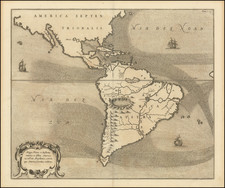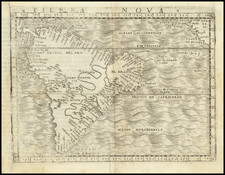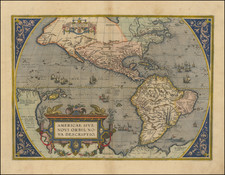Striking Coronelli Map of the South Seas Showing the Latest Dutch Discoveries
Nice example of Coronelli's map of the Pacific Ocean, published in Venice. The map depicts the west-coast of America south to Tierra del Fuego. To the east, it shows Tartary, Japan, New Guinea, and the first suggestions of Van Diemen's Land. In between are many islands, including a large Terra de Iesso to the north and, to the south, New Zealand. The latter is connected to a larger shoreline marked as still unknown.
Rhumb lines divide and intersect the ocean. Off the coast of South America is a large block of text describing the prevailing winds and the distances across the sea. A large cartouche is in the upper right corner, shaped like an clam shell, which holds the title in the top half and pearls, coral, and seaweed in the bottom half. Surrounding the title are three mermaid putti. One holds aloft a shield adorned with a double-headed eagle. The other two hold open the massive shell. The entire cartouche suggests to the reader that the Pacific Ocean holds the possibility of riches for those that can master its watery distances.
The Pacific, ca. 1690: From Spanish Lake to Dutch Pond
As with many contemporary maps, California is shown here as an island. On its first portrayal on a printed map by Diego Gutiérrez, in 1562, California was shown as part of North America. This was repeated by other mapmakers, including Mercator and Ortelius. In the 1620s, however, California began to appear as an island in several sources, including Samuel Purchas' Hakluytus Posthumus or Purchas his Pilgrimes (1625).
This was most likely the result of a reading of the travel account of Sebastian Vizcaino, who had been sent north up the shore of California in 1602. A Carmelite friar who accompanied him described the land as an island and sketched maps to that effect. Normally, this information would have been reviewed and locked in the Spanish repository, the Casa de la Contractación, but the ship carrying the map and other Vizcaino documents was captured by the Dutch. Prominent practitioners like John Speed, Jans Jansson, and Nicolas Sanson adopted the new island and the practice became commonplace. Even after Father Eusebio Kino published a map based on his travels refuting the claim (Paris, 1705), the island remained a fixture until the mid-eighteenth century.
Stealing Spanish documents was not the only influence the Dutch had on Pacific cartography. The Spanish had been a presence across the Pacific since the mid-sixteenth century, and their impact is visible on this map in the Spanish toponyms for islands that stretch across the Northern Pacific to the Ladrones. These islands were discovered by ships involved in the silver galleon circuit that passed between Acapulco and Manila each year. However, most of the notes Coronelli made on the map refer not to the Spanish, but the Dutch.
North of Japan is a large landmass labeled as Terra d'Iesso e Eeco. This island is on many eighteenth-century maps. Historically, Eso (Yedso, Yesso) refers to the island of Hokkaido. It varies from a small island to a near-continent sized mass that stretches from Asia to Alaska. Here, however, Coronelli tells the reader that the Dutch discovered the island in 1645, which indicates that he is eliding Yesso with two other North Pacific chimeras, Gamaland and Compagnies Land.
Juan, the grandson of Vasco de Gama, was a Portuguese navigator who was accused of illegal trading with the Spanish in the East Indies. Gama fled and sailed from Macau to Japan in the later sixteenth century. He then struck out east, across the Pacific, and supposedly saw lands in the North Pacific. These lands were initially shown as small islands on Portuguese charts, but ballooned into a continent-sized landmass in later representations. Several voyagers sought out de Gama's lands, including the Dutchmen Matthijs Hendrickszoon Quast in 1639 and Maarten Gerritszoon Vries in 1643. After this map's publication, Vitus Bering, a Danish explorer in Russian employ, and James Cook would both check the area and find nothing, finally putting to rest the myth of Gamaland.
Compagnies Land, along with Staten Land, were islands sighted by Vries on his 1643 voyage. He named the island for the Dutch States General (Staten Land) and for the Dutch East India Company (VOC) (Compagnies, or Company's Land). In reality, he had re-discovered two of the Kuril Islands. However, other mapmakers latched onto Compagnies Land in particular, enlarging and merging it with Yesso and/or Gamaland. It is clear Coronelli had Vries and his voyage in mind, as a strait to the east of Yesso is named Stretto Vriez.
The voyages of Le Maire and Schouten and Tasman
The only ship's track that is marked on the map is that of Le Maire, who Coronelli proclaims, "found a new passage from the South Sea to the North Sea." In 1615, independent Dutch merchants sent Cornelius Schouten and Isaac Le Maire to see if they could steer around Tierra del Fuego, rather than through the Straits of Magellan. This is because the VOC had been granted a monopoly on trade that passed through the Straits, choking out all other competitors. From 1615-1617, Schouten and Le Maire circumnavigated the globe, entering the Pacific via a strait that sent their ships around Cape Horn.
Thanks to a popular travel account that was translated into several European languages, the Le Maire voyage was celebrated by those who wanted to access the Pacific for trade. The merchants of the Republic of Venice were likely thrilled at the possibility, or at least Coronelli thinks they should be, which is why he has included the track on his map.
Another Dutch voyager looms large on this map: Abel Tasman. In 1642, Governor-general Anthonie Van Diemen charged Tasman to sail to the southeast in search of new lands. The expedition visited Van Diemen's Land (Tasmania), the west coast of New Zealand, Tonga, and Fiji; New Zealand and Van Diemen's Land especially are emphasized on Coronelli's map. New Zealand's eastern shore has been linked with a still unknown coastline, suggesting New Zealand is actually the tip of a large southern continent.
Van Diemen was disappointed that Tasman had not set up trade relations or learned of the resources available on the islands. The VOC gave Tasman another chance in 1644, this time telling him to find something profitable Van Diemen ordered Tasman to investigate the possibility of a strait between New Guinea and New Holland, as the Torres Strait, discovered in the early seventeenth century, was not included on contemporary VOC charts. He also wanted Tasman to explore the approach to Van Diemen's Land. On the first count Tasman, like his Dutch predecessors, took the entrance to the Torres Strait for a shallow bay. It is shown as an unresolved gap by Coronelli.
As to the second count, the short cut to Van Diemen's Land proved to be the Gulf of Carpentaria, discovered in 1606 by fellow Dutchman Willem Janszoon. Little did they know there was the entire continent of Australia between the Gulf and Van Diemen's Land. Tasman sailed along the entire coast of New Guinea but these results were even paltrier than his first expedition. Tasman's failure in the eyes of the VOC was the death knell for Dutch exploration in the Pacific. However, the Dutch contributions helped to redraw the map of the Pacific, as Coronelli's map shows.
Coronelli and his globes
Vincenzo Maria Coronelli (1650-1718) is one of the most influential Italian mapmakers and is known especially for his globes and atlases. The son of a tailor, Vincenzo was apprenticed to a xylographer (a wood block engraver) at a young age. At fifteen he became a novice in a Franciscan monastery. At sixteen he published his first book, the first of 140 publications he would write in his lifetime. The order recognized his intellectual ability and saw him educated in Venice and Rome. He earned a doctorate in theology, but also studied astronomy. By the late 1670s, he was working on geography and was commissioned to create a set of globes for the Duke of Parma. These globes were five feet in diameter. The Parma globes led to Coronelli being named theologian to the Duke and receiving a bigger commission, this one from Louis XIV of France. Coronelli moved to Paris for two years to construct the King's huge globes, which are 12.5 feet in diameter and weigh 2 tons.
The globes for the French King led to a craze for Coronelli's work and he traveled Europe making globes for the ultra-elite. By 1705, he had returned to Venice. There, he founded the first geographical society, the Accademia Cosmografica degli Argonauti and was named Cosmographer of the Republic of Venice. He died in 1718.
This map appeared in the 1691 edition of the Atlante Veneto, Coronelli's atlas that was supposed to carry on the work of Blaeu's Atlas Maior. The Pacific map appeared in the third section, which dealt with hydrography.
Thomas Suarez, Early Mapping of the Pacific (Hong Kong: Periplus, 2004).
Lawrence C. Wroth, “The Early Cartography of the Pacific,” The Papers of the Bibliographical Society of America 38, no. 2 (1944): 87-268.
Vincenzo Maria Coronelli (1650-1718) was one of the most influential Italian mapmakers and was known especially for his globes and atlases. The son of a tailor, Vincenzo was apprenticed to a xylographer (a wood block engraver) at a young age. At fifteen he became a novice in a Franciscan monastery. At sixteen he published his first book, the first of 140 publications he would write in his lifetime. The order recognized his intellectual ability and saw him educated in Venice and Rome. He earned a doctorate in theology, but also studied astronomy. By the late 1670s, he was working on geography and was commissioned to create a set of globes for the Duke of Parma. These globes were five feet in diameter. The Parma globes led to Coronelli being named theologian to the Duke and receiving a bigger commission, this one from Louis XIV of France. Coronelli moved to Paris for two years to construct the King’s huge globes, which are 12.5 feet in diameter and weigh 2 tons.
The globes for the French King led to a craze for Coronelli’s work and he traveled Europe making globes for the ultra-elite. By 1705, he had returned to Venice. There, he founded the first geographical society, the Accademia Cosmografica degli Argonauti and was named Cosmographer of the Republic of Venice. He died in 1718.










![[ Karte des Nordens von America, Zur Beurtheilung der Wahrscheinlichkeit einer nord=westlichen Durchfhart, gezeichnet von G. Forster, 1791.]](https://storage.googleapis.com/raremaps/img/small/41816dm.jpg)
![Information Concerning the Terminus of the Railroad System of the Pacific Coast [with maps:] Map of California, Showing the Railroad System [and:] E.C. Sessions' Map of Oakland and Brooklyn](https://storage.googleapis.com/raremaps/img/small/83969.jpg)
![(Early California Trade) [Royal Decree of October 22,1803, to encourage trade in California]. D. Joseph de Yturrigaray, Caballero profeso de la Orden de Santiago, Teniente General de los Reales Exércitos, Virrey, Gobernador...Con fecha de 22 de Octubre del año proximo anterior...la Real Orden...Con objeto de fomentar la Agricultura y Comercio de las Californias, se ha servido el Rey habilitar sus Puertos en calidad de menores...](https://storage.googleapis.com/raremaps/img/small/93851.jpg)

